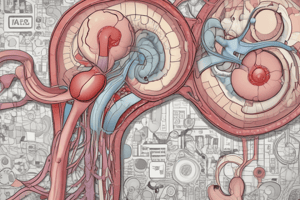Podcast
Questions and Answers
What is the primary role of fatty acid oxidation in proximal tubules?
What is the primary role of fatty acid oxidation in proximal tubules?
- To increase protein acetylation
- To reduce glycolytic capacity
- To accumulate lipids in tubular cells
- To generate energy for mitochondrial oxidative metabolism (correct)
What is the consequence of increased protein acetylation in diabetic kidney disease?
What is the consequence of increased protein acetylation in diabetic kidney disease?
- Reduced fatty acid β-oxidation
- Enhanced renal fibrosis
- Increased glycolysis
- Mitochondrial dysfunction (correct)
What is the significance of TCA cycle intermediates in diabetic kidney disease?
What is the significance of TCA cycle intermediates in diabetic kidney disease?
- They are elevated in urine samples of diabetic patients and predict diabetic kidney disease progression (correct)
- They are potential therapeutic targets for diabetic kidney disease
- They are decreased in urine samples of diabetic patients
- They are not affected in diabetic kidney disease
What is the main difference between diabetic and nondiabetic CKD in terms of metabolic reprogramming?
What is the main difference between diabetic and nondiabetic CKD in terms of metabolic reprogramming?
What is the primary mechanism by which lipid accumulation contributes to renal fibrosis in CKD?
What is the primary mechanism by which lipid accumulation contributes to renal fibrosis in CKD?
Flashcards are hidden until you start studying
Study Notes
Tubular Metabolism in CKD
- Recent studies have explored metabolic alterations in various forms of chronic kidney disease (CKD).
- Metabolic reprogramming is central to the pathophysiology of CKD, with alterations in glucose and fatty acid metabolism occurring early in the course of diabetic and other forms of CKD.
Glucose Metabolism in CKD
- Defective glucose metabolism, specifically increased aerobic glycolysis, was observed in mouse models of autosomal dominant polycystic kidney disease (ADPKD) and in kidney tissue from patients with ADPKD.
- Treatment with 2-deoxyglucose, an inhibitor of glycolysis, lowered kidney weight, volume, cystic index, and proliferation rates in mouse models of ADPKD.
- The Warburg effect, characterized by enhanced aerobic glycolysis, is typically seen in proliferating cancer cells.
Fatty Acid Metabolism in CKD
- Changes in fatty acid metabolism in the kidney have been described in CKD, with reduced levels of enzymes and regulators involved in fatty acid oxidation in mouse models of fibrosis.
- Genes related to fatty acid metabolism and their key transcriptional regulator complex, PPARA–PPARGC1A, were markedly lower in CKD samples compared with samples from people with normal kidney function.
- Lipid accumulation in renal tubular epithelial cells was higher in CKD samples.
Metabolic Reprogramming in Diabetic CKD
- Proximal tubules are largely dependent on mitochondrial oxidative metabolism for energy with limited glycolytic capacity.
- In diabetes, there are increases in plasma concentration of glucose and fatty acids, which are also found intracellularly in the kidneys, particularly proximal tubules.
- Increased renal metabolism is associated with increased protein acetylation, a nutrient sensing posttranslational modification.
- Mitochondrial dysfunction is also evident in diabetic CKD.
Metabolic Alterations in Diabetic Nephropathy
- Transcriptomic and metabolomic profiling in a type 2 diabetic mouse model demonstrated an increase in glycolysis, fatty acid β-oxidation, and tricarboxylic acid (TCA) cycle flux.
- Urine samples from diabetic patients showed increased glycolytic and TCA cycle metabolites compared with healthy control subjects.
- TCA cycle intermediates in the urine were elevated in diabetic subjects and predicted diabetic kidney disease progression, demonstrating their potential as prognostic biomarkers.
Studying That Suits You
Use AI to generate personalized quizzes and flashcards to suit your learning preferences.



